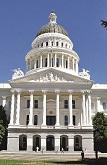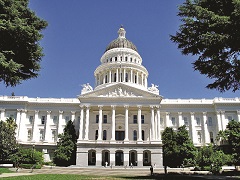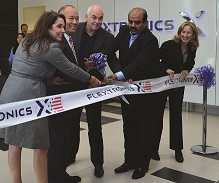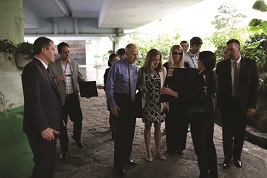

A Snapshot of California
California is not only the largest, richest and most diverse economy in the United States, but also one of the nation’s fastest-growing economies and a national leader in job creation. California leads the nation in several economic categories: it is the No. 1 state for manufacturing and technology and for capital access and it is home to the nation’s most Fortune 500 companies.
As the economy becomes increasingly global, international achievement is important to a sustainably successful economy as well. California is a global leader in agricultural output and export, in attracting and retaining international talent and investment, in innovation and entrepreneurship and in higher education and workforce readiness. California is now the seventh-largest economy in the world — gross state product is over $2.25 trillion. In the last two years, California has surpassed Russia, Italy and most recently Brazil.
Quality of life is important for attracting new business and an outstanding workforce, and that’s another area where the state excels. California’s quality of life standards set one of the highest bars in the nation.
California Economy by the Numbers
In 2014, California added 498,000 jobs, by far the most in the nation. The next closest state was 105,000 jobs behind California. The state is home to more venture capital, patents, tourism, Fortune 500 companies, agriculture, biotech and manufacturing output than any other state.
Since 2011, California’s economy has grown an average of 4.1 percent annually, and the outlook indicates growth will continue. In fact, analysts are more bullish on California-based businesses than on U.S. companies. Companies based in the state will provide a 15 percent return to investors in the coming year, compared with 12 percent for the index. (Russell 3000 index)
The per-capita annual income in California was estimated to have increased by $1,700 to $50,338 in 2014, according to state data. After four years of on-time and balanced budgets, at the end of this fiscal year on July 2015, California is projected to have a budget surplus of more than $5 billion.

Agriculture, technology and manufacturing are key California industries and in each, California leads all U.S. states’ revenue growth. California-based technology companies brought in $692 billion in revenue in the past 12 months, about half the industry’s sales across the U.S. The value of manufacturing in California climbed eight percent to $239 billion in 2013, and California’s agriculture sector produced $21 billion in revenue in 2013.
The number of companies in California that rank in the top 500 in the world in terms of market capitalization rose almost 48 percent since 2009, while high-technology jobs continue to expand.
Manufacturing
California is driving the U.S. manufacturing renaissance as the nation’s leader in advanced manufacturing. California is the No. 1 state for manufacturing in terms of total firms, jobs and output. California has twice the number of manufacturing companies as the next closest state in this category.
-
Total Firms: 38,000
-
Total Jobs: 1.25 million
-
Total Output: $239 billion
-
Percent of Workforce: 8.02.
In addition, California has added manufacturing jobs for four consecutive years, which is the first time that has happened in decades.
Innovation and High-tech
-
1,087,800 tech industry workers in 2014 (the first-ranked cyberstate)
-
32,900 net jobs added between 2013 and 2014, ranked first nationwide
-
Tech firms employed 8.1 percent of private sector workers in 2014, ranked sixth nationwide
-
Tech industry workers earned an average wage of $139,500 (first ranked), 147 percent more than California’s average private sector wage
-
A tech payroll of $152 billion in 2014, ranked first nationwide, accounting for nearly 20 percent of all private sector payroll in California
-
46,300 tech establishments in 2013, ranked first nationwide
-
101,500 tech occupational job openings in Q4 2014
-
10.1 percent of the state economy is from the tech industry.

Governor Brown enacted a new Economic Development Initiative that brought together business leaders, labor interests and legislators from both sides of the aisle. This created a more flexible, more competitive set of economic development tools designed to incentivize companies to locate or expand in CA. The Governor’s Office of Business and Economic Development will allocate $789 million to companies that want to expand in California and add jobs.
Below are some of the incentive programs the State of California offers:
-
California Competes Tax Credit, an income tax credit available to businesses that want to come to California or stay and grow in California.
-
(Partial) Sales and Use Tax Exemption, applicable to certain manufacturing biotechnology and research and development equipment purchases.
-
(Full) Sales and Use Tax Exclusion – for equipment purchases made by qualifying businesses for advanced manufacturing, alternative energy and transportation.
-
The New Employment Credit (NEC) is available for each taxable year to a qualified taxpayer that hires a qualified full-time employee
-
California Research & Development Tax Credit, available to companies that have incurred qualified research expenses in California.
-
Employment Training Panel, a cash reimbursement for training costs
-
Industrial Development Bond (IDB), a competitive financing option available for the acquisition of manufacturing facilities and equipment
-
Small Business Loan Guarantee (SBLGP), which assists businesses with the creation and retention of jobs while encouraging investment into low- to moderate-income communities.
-
CalCAP CS, which pledges cash to cover the collateral shortfall of loans of $100,000 or more
-
Pollution Control Tax-Exempt Bond Financing Program, providing private activity tax-exempt bond financing to California businesses for the acquisition, construction or installation of qualified pollution control, waste disposal, waste recovery facilities and the acquisition and installation of new equipment.
-
California Capital Access Program, which encourages participating banks and lending institutions to provide loans to small businesses that fall outside of conventional underwriting standards
-
California Film & Television Tax Credit Program, a tax credit incentive program to qualified motion pictures.

California is building the most sophisticated economic development program in the country. Firms looking to relocate or expand in California can contact the Governor’s Office of Business and Economic Development (GO-Biz). GO-Biz serves as the state’s single point of contact for economic development specialists advising on site selection, permit streamlining, clearing regulatory challenges, small business assistance and international trade development. GO-Biz provides no-fee, tailored site selection services to employers, corporate real estate executives and site location consultants considering California for business investment.
In the past eight months, GO-Biz has awarded over $60 million to 85 companies that are either relocating or expanding in California and are projected to create over 10,000 jobs and make close to $3 billion in investments.
California also aims to keep progress on track with targeted job creation programs. The state has established the biggest network of state-sponsored Innovation Hubs, stretching from Redding to San Diego, each specializing in a different innovation discipline from biotech to aerospace manufacturing.
One of the largest and most accessible business expansion tax credits in the U.S. – California Competes – is projected to award $200 million in 2015-16 to companies adding jobs in the state. California also delivers the largest film tax credit in the U.S. at $330 million, available to film and TV, attracting more business and increasing jobs in the entertainment sector.
The state also has launched the largest and most aggressive tourism marketing initiative in the U.S. and will spend a projected $100 million in 2015-16 marketing the benefits of California as a destination for both tourists and businesses.
Bottom line; California’s economy is thriving and the state is taking action to ensure that momentum continues.

